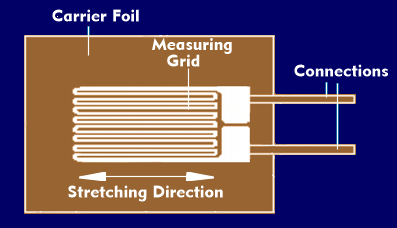strain gauge
A strain gauge is a sensor whose resistance value changes with strain. The change in resistance is due to the minimal change in the conductor structure when stretched. When the conductor is stretched longitudinally, the conductor structure becomes thinner and longer, resulting in higher resistance. It is this minimal change in resistance that serves as the measured value. To increase the sensitivity of strain gauges, they are meander-shaped, which makes the conductor longer overall.
In electronic circuitry, bridge circuits are used when minimal changes in voltage, current or resistance need to be detected. This is also the case with strain gauges. To detect the relatively small resistance changes, strain gauges are connected in bridge circuits such as the Wheatstone bridge and the voltage differences are amplified in downstream differential amplifiers.
Strain gauges are used in pressure sensors, they are made of metal or semi-materials, mainly silicon and germanium, and have a relatively low resistance of a few hundred ohms, typically 100 ohms to 600 ohms. The change in resistance is about 0.1 to 0.3 ohms. Compared to the metallic ones, the semiconductor strain gauges have a much higher sensitivity, but also a poorer temperature stability. They are bonded to the parts to be monitored and change their resistance with expansion.
Strain gauges can be used for slow processes but also for pressure or load changes up to the kilohertz range. They are used in scales, in pressure transducers, in deformation technology, in materials testing and in production to measuretensile loads and compressive loads in the manufacture of paper, films or wires.


